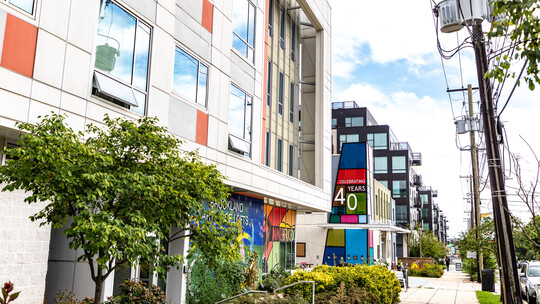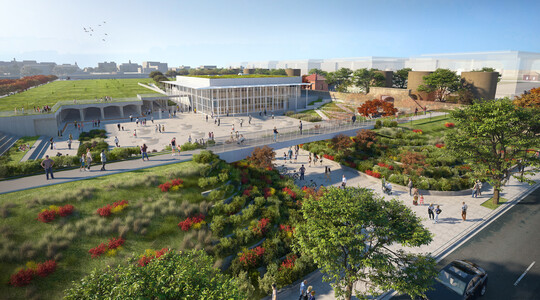June 2023 Edition

Dear Customers,
Earlier this month, we celebrated World Environment Day, a day for each of us to encourage awareness and action to protect the environment across the globe. As you may know, I am a LEED certified and registered Architect and am committed to guiding construction projects sustainably to a successful completion. This is a core passion of mine, which will continue in my role as Acting Director for the Department of Buildings (DOB). As a former Director of the Department of General Services (DGS), I led the District's first power purchase agreement for renewable energy for both solar and wind, and continue to learn and apply practical knowledge about green building practices and sustainability in the built environment.
As I look at the District, I see so much potential to engage intentionally and intelligently with our built environment as part of Mayor Bowser's DC Comeback Plan. DOB can be a key contributor to enhancing the District by committing to excellent customer service, investing in efforts to streamline stakeholder interactions with our agency to generate economic development, and operating effectively as a trusted advisor and regional leader to promote community resilience.
My excitement for the future of DC's built environment and high potential as a dynamic economic engine is understandably informed by the value I place on sustainability. As we work to build a stronger and better District, environmental issues must play a central role. DOB's Green Building division is a key player in District government's work to shepherd smart growth and development projects.
I am engaging with our team to think of innovative ways that we can engage with building and construction industry professionals to foster sustainable building practices to best serve our community. As always, we are collaborating consistently with the Department of Energy and Environment (DOEE), District Department of Transportation (DDOT), Department of Licensing and Consumer Protection (DLCP), and other District agencies. As we work together with the community to determine solutions to some of the District's biggest challenges, I am excited to hear your thoughts and suggestions in the coming days. Our path forward is only passable with your trust and our commitment to our mission.
Onward,
|
 Brian J. Hanlon, AIA LEED AP®
Acting Director
 Sustainability shapes the cities of today allowing them to evolve into the cities of tomorrow. The world faces pressing environmental challenges, and urban planners, architects, and policymakers are taking a host of proactive steps to craft cities that are not only functional and vibrant, but also environmentally responsible and sustainable. Here are just a few ways that sustainability is playing a key role in transforming our cities for a greener future:
🌿 Urban Planning for Sustainability
City planning is at the forefront of sustainable development. The integration of sustainable practices in urban planning involves thoughtful consideration of various factors, such as land use, transportation, energy efficiency, and waste management. By strategically designing compact, mixed-use developments that prioritize walkability, access to public transportation, and the preservation of green spaces, cities can reduce carbon emissions, alleviate traffic congestion, and enhance the quality of life for their residents. DOB acts as a key partner in the development, permitting, and construction of these developments. When we process a permit application and give the go-ahead for a project to go forward, we are providing an avenue for economic opportunity and community development to take place at an increased level.
🌎 Renewable Energy Integration
Sustainable cities are increasingly embracing renewable energy sources as a means to reduce their carbon footprint. The integration of solar panels on rooftops, wind turbines in urban landscapes, and the use of geothermal energy are just a few examples of how cities are transitioning towards clean energy. By investing in renewable energy infrastructure, cities can reduce their dependence on fossil fuels, promote energy independence, and contribute to global efforts in combating climate change. Here in the District, we work closely with some of the tech world's brightest minds to establish and implement new technologies that make DC more sustainable.
🏢 Green Buildings and Infrastructure
The construction sector is a major contributor to greenhouse gas emissions. To address this, sustainable cities are focusing on green building practices. Energy-efficient designs, use of sustainable materials, proper insulation, and advanced technologies like smart energy management systems are transforming the way buildings are constructed.
By embracing sustainability as a guiding principle, cities have the ability to be pioneers in the battle against climate change and lead the way towards a greener future. As the nation's capital, it is important that the District continues to invest in its leadership in this arena to model for cities across the country.
Located within our Office of Construction and Building Standards, DOB's Green Building division is responsible for regulating construction in the District that falls under the regulations of the Green Building Act, Green Construction Code, and Energy Conservation Code. The division is responsible for plan reviews, building inspections, certificate of occupancy review, training, and education. The Green Building division collaborates with sister agencies such as DOEE, the building industry, and the community to further efforts to build a more sustainable DC.
 Pollinator and Rain Gardens
Intelligently utilizing the green space in the District is a high priority for District government and many property owners. Earlier this year, we shared information in our newsletter about pollinator and rain gardens. We also provided valuable information from DOEE on how property owners can utilize green space in these manners.
Grass Enforcement Season
District regulations (12-G DCMR, Section 302 Exterior Property Areas) prohibit property owners – both commercial and residential – from allowing grass and weeds on their premises to grow more than eight inches in height. Failing to adhere to the law could lead to fines. All exterior property and premises should be maintained in a clean, safe, and sanitary condition.
DOB regulates several types of excessive vegetative growth, including weeds, grasses, kudzu, poison ivy, oak, sumac, plants with heavy odors, and any other causing hay fever. Regulations require that these weeds be cut after no more than seven days of growth.
Annually, May 1 through October 31 is grass enforcement season. DOB can clean a property (i.e., mow a property's lawn and remove vegetation) and issue fines to the property owner. The fine (cost of the abatement) is determined by the number of employees and equipment used, and total time spent at the property.
From November 1 through April 30, once a property is inspected and posted for excessive vegetation (growth in excess of eight inches, DOB allows the owner seven business days to respond and comply before mowing the property’s lawn. If there is no response, a re-inspection is conducted. If the violation still exists, DOB will make arrangements to abate. Abatement can take up to four weeks after the initial inspection.
How To Report Overgrowth
Residents should report properties with grass and/or weeds exceeding
eight inches directly through directly to DOB through the District’s 311
system. You can report your service requests by either calling 311,
visiting the 311.dc.gov, using the mobile app (DC311), using our online
live chat feature during standard business hours, texting DC311, or
tweeting to @311dcgov. Please have the exact address of the property
before making a complaint.
Why Is Grass Height So Important?
Excessive vegetative growth can have serious public health
implications. Tall grass can trigger respiratory problems like asthma
and allergies in District residents and visitors. Weeds can also create a breeding place for mosquitoes, rats, mice, snakes and other vermin which are drawn to grass and weed overgrowth. Vegetation may be defined as any grasses, weeds, or plants at any state of maturity that:
- Exceeds more than eight inches in height, is untended, or creates a
dense area of shrubbery that is a detriment to the health, safety
and welfare of the public;
- Creates a harbor (including hiding places for persons) or provides a
place to conceal refuge or trash, regardless of height;
- Develops into deposits, or accumulation of, refuge or trash;
Harbors rodents and vermin or provides a refuge for snakes, rats or
other rodents;
- Creates an unpleasant or noxious odor;
- Constitutes a fire hazard; or
- Contains grass or weeds that are dead.
By working together, we can ensure that the District stays green while cutting down on excessive grass and vegetation growth.
 A rendering of the McMillan Sand Filtration Site redevelopment
Earlier this month, members of our account management team joined Mayor Bowser, multiple District government agencies, and resident and local stakeholders to celebrate progress on the McMillan Sand Filtration Site redevelopment in Northwest. The site will house a 6.2 acre park and 17,000 square-foot community center, and is expected to be completed next year.
The project is a large part of DC's Comeback, showcasing many different manners of what that looks like – creating jobs for our community members, addressing gaps in access equity to amenities and services, and building more homes to house present and future District residents. DOB is proud to join the community to mark progress on community-driven projects such as these, and relish the opportunity to engage with stakeholders to answer any questions about our work.
Contact DOB via email at dob@dc.gov, through our online inquiry form or during normal business hours using the live chat available on dob.dc.gov or by phone at 202.671.3500, and we will get back to you in three business days or less.
|